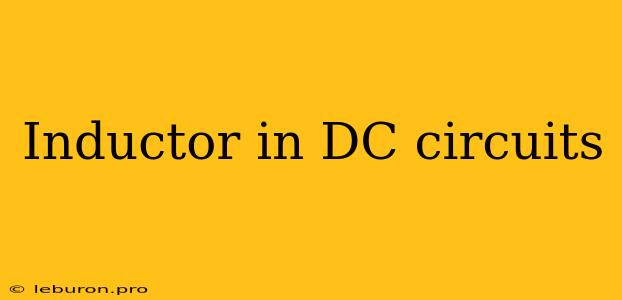Inductors are passive electronic components that store energy in a magnetic field when electric current flows through them. They are typically made of a coil of wire wound around a core material. While inductors are commonly associated with AC circuits due to their role in filtering and tuning, they also play a crucial role in DC circuits, albeit in a less flashy manner. This article delves into the behavior of inductors in DC circuits, exploring their characteristics, applications, and how they interact with other components.
Understanding Inductors in DC Circuits
In a DC circuit, where the current flow is constant, an inductor exhibits unique behavior compared to its role in AC circuits. Here's a breakdown of key aspects:
Inductors and DC Resistance
- Inductors have DC resistance: While the primary function of an inductor is to resist changes in current, it also possesses a small amount of DC resistance. This resistance stems from the wire used in the coil's construction and can be measured in ohms.
- DC resistance impacts power dissipation: This inherent DC resistance leads to power dissipation in the inductor when DC current flows through it. The dissipated power can be calculated using the formula P = I²R, where P is power, I is current, and R is the DC resistance.
Inductors and the Transient Response
The most intriguing aspect of inductors in DC circuits lies in their transient behavior. This refers to the inductor's response during the initial stages of current flow and when the current is interrupted.
- Inductor opposes changes in current: When a DC voltage is first applied to an inductor, the inductor resists the increase in current. This resistance is due to the magnetic field that builds up around the coil. This magnetic field acts as a counter-electromotive force (CEMF) opposing the applied voltage.
- The time constant: The rate at which the current builds up in an inductor is governed by the time constant, denoted by the Greek letter τ. The time constant is determined by the inductor's inductance (L) and the circuit's resistance (R) and calculated as τ = L/R. It represents the time required for the current to reach approximately 63.2% of its final value.
- Steady-state condition: After a period of time equal to several time constants, the current in the inductor reaches a steady-state value. At this point, the inductor behaves like a short circuit, offering minimal resistance to the flow of DC current.
Applications of Inductors in DC Circuits
Inductors in DC circuits find applications in various scenarios:
- Smoothing: Inductors are used to smooth out voltage fluctuations in DC power supplies. By storing energy during periods of high voltage and releasing it during periods of low voltage, inductors create a more stable DC output.
- Energy storage: Inductors can be used to store energy in DC systems, similar to capacitors. This energy can be released quickly when needed, making inductors suitable for applications like pulsed power systems.
- DC-DC converters: Inductors are essential components in DC-DC converters, which convert one DC voltage level to another. They help regulate the output voltage and smooth out current flow.
Factors Influencing Inductor Behavior in DC Circuits
The behavior of inductors in DC circuits is influenced by several factors:
- Inductance: The inductance value, measured in Henries (H), is directly proportional to the inductor's ability to resist changes in current. A higher inductance value leads to a longer time constant and slower current buildup.
- Resistance: The resistance of the circuit, including the inherent DC resistance of the inductor itself, determines the time constant and affects the rate of current change.
- Voltage: The applied DC voltage determines the final steady-state current through the inductor.
Understanding the Importance of Inductors in DC Circuits
While inductors in DC circuits may not be as prominent as in AC circuits, they play a crucial role in many practical applications. They provide a means to control current flow, smooth out voltage fluctuations, and store energy. By understanding their behavior and the factors that influence them, designers can effectively incorporate inductors into their DC circuits to achieve desired functionality and optimize performance.
In conclusion, inductors in DC circuits are passive components with unique characteristics that make them valuable tools for various applications. Their ability to resist changes in current, smooth out voltage fluctuations, and store energy makes them essential in DC power supply systems, energy storage solutions, and various electronic circuits. Understanding their behavior and the factors that influence it is crucial for successful circuit design and optimization.
